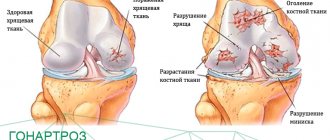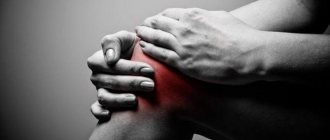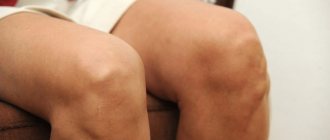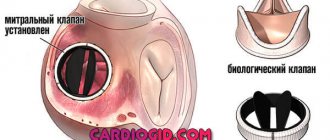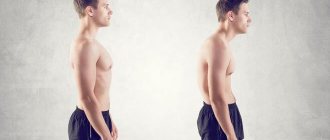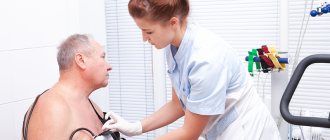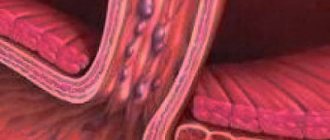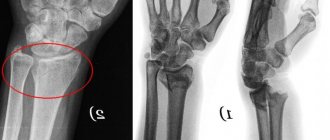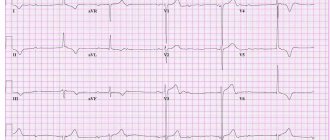Deforming arthrosis of the knee joint, in medicine called gonarthrosis, is a degenerative disease in the hyaline cartilage of the knee, which covers the condyles of the femur and tibia.
With arthrosis of the knee joint, symptoms develop gradually over years, the main manifestation of the disease being pain and stiffness when moving. It is gonarthrosis that is considered the most common disease among arthrosis of other joints, such as hip arthrosis, arthrosis of the elbow or shoulder joints, and phalanges of the fingers.
Most often, the disease affects people over 40 years of age; women are most susceptible to arthrosis. Sometimes it develops in young people due to injury or in athletes from excessive stress.
General information
Osteoarthritis of the knee , also called gonarthrosis , can significantly impair a person’s quality of life.
As the disease progresses, there is a gradual loss of hyaline cartilage in the joint. Gradually, the cartilage loses density and height. Its fibering and thinning are noted, and over time it disappears completely. Accordingly, there is no soft protective cushion in the bone, and this leads to increased stress on the end plate of the innervated articular surface of the bone. As a result of this load, pain develops. The ICD-10 code for arthrosis of the knee joint is M17. The knee joint is affected quite often, since it is the knee that bears a significant load during walking, physical effort, and running. In this case, awkward movements can lead to injury to the soft tissues of the knee and cause arthrosis. That is why gonarthrosis is one of the main causes of disability. According to statistics, this disease affects about 20% of people on the planet to varying degrees.
Why arthrosis develops, how to prevent the development of this disease, which doctor treats arthrosis of the knee joint, and what treatment methods the doctor can recommend after making a diagnosis will be discussed in this article.
Diagnostics
Suspicion of the development of gonarthrosis is considered a good reason to visit a doctor. When you notice the first signs of the disease, it is advisable to make an appointment with an orthopedist. You may need to consult a surgeon or rheumatologist.
The diagnosis will be made based on the results of laboratory and instrumental research methods. The patient is sent for laboratory tests:
- Blood (general analysis, biochemical);
- general urine analysis.
Laboratory research data is necessary to exclude autoimmune diseases that provoke damage to the joints. They help determine the presence of inflammation within the body.
Instrumental diagnostics are also carried out. It is represented by the following methods:
- Ultrasound;
- radiography;
- CT;
- MRI.
Pathogenesis
The disease develops against the background of a discrepancy between the load on the joint and its ability to withstand it. In this case, the properties of cartilage can be determined by genetics or change due to the influence of acquired factors - both exogenous and endogenous. The development and progression of gonarthrosis can occur with age, against the background of obesity , due to dysplasia of the femoral-patellar joint or changes in the axis of the lower limb, disorders of the biomechanics of the joint, damage to the menisci and ligaments, etc.
The basis of pathogenesis is the predominance of catabolic processes over anabolic ones, which is noted in the cartilaginous and subchondral bone, menisci and synovial membrane. As a result, structural changes occur and the biological properties of cartilage are lost. The pathological process then spreads to the muscles and ligaments.
The basis of articular cartilage is the connective tissue matrix and chondrocytes. The connective tissue matrix contains molecules collagen and aggrecan. The shock-absorbing properties of cartilage are ensured precisely due to the connective tissue matrix.
The inflammatory process in arthrosis is not as intense as in arthritis . However, in osteoarthritis, proinflammatory mediators are also present.
Classification
According to the origin of gonarthrosis, the following types are distinguished:
- Primary (idiopathic) - develops without the influence of any external causes.
- Secondary – certain factors lead to the development of the disease. Most often they are associated with injuries, fractures, surgical interventions on the joint, as well as inflammatory factors - acute and chronic arthritis, etc.
The following degrees of arthrosis of the knee joint are also determined:
- Arthrosis of the 1st degree - is determined in the period from the appearance of the first signs of the disease to the development of bone deformations, noticeable on x-rays or during examination. During this period, pain of varying intensity appears during movement.
- At degree 2 – unpleasant sensations are observed even at the slightest load. When walking and squatting, the knee crunches, and joint mobility decreases. The image shows the growth of bone tissue along the edges of the joint, as well as the narrowing of the joint space. Upon external examination, it can be noted that the knee is increased in size.
- At grade 3, there is practically no cartilage tissue inside the joint. If the disease progresses, the bones can fuse together, which causes complete immobility of the leg. Sleep is disturbed, it becomes impossible to move without a stick or crutch.
The following types of this disease are also distinguished:
- Patellofemoral arthrosis of the knee joint is a condition in which degenerative changes are observed in the posterior part of the patella, that is, the kneecap. With this form of the disease, pain primarily occurs when descending stairs or from a mountain. Patellofemoral arthrosis can develop in runners. The disease is often diagnosed in young people.
- Post-traumatic arthrosis of the knee joint is a consequence of an injury. The post-traumatic type of illness may not initially manifest itself. But later the person loses full motor activity of the joint.
Reviews from people
You can learn from people’s reviews about which methods of combating arthrosis are the most effective. Here's what patients say about the different therapies:
- For the past 5 years I have been regularly taking courses of injections into the joint - it is painful, but effective: after three injections it becomes noticeably easier, there is no pain and I can walk normally. It lasts for a year, then you have to repeat it. Valentina, 45 years old, Kostroma.
- Diclofenac helped me well, but then I had stomach problems, was diagnosed with gastritis, and had to give up diclofenac. On the doctor’s recommendation, I tried Dona, I’ve been drinking it for the second month now, but there’s no significant improvement yet. Nadezhda, 42 years old, Murmansk.
- I have been living with arthrosis of the hip joint for 12 years. I had an arthroscopy, and at first everything was fine, but after a year and a half the pain returned and I began to limp again. Now the doctor recommends installing an endoprosthesis. But I’m not sure of the result - I’m afraid of complications. Andrey Ivanovich, 63 years old, Saratov.
Experience with the use of various joint therapies proves that treatment should begin at an early stage of the disease. The more injured the joint, the more difficult it is to achieve a positive effect.
Causes of arthrosis of the knee joint
Today, work is still underway to study the reasons leading to the development of such pathology. At the moment, the causes of gonarthrosis are associated with the influence of the following factors:
- Age - at a certain age, a person begins to experience degenerative changes in tissues, and the ability of cartilage tissue to regenerate decreases.
- Arthritis – Over time, arthritis can lead to the development of arthrosis.
- Previous injuries and overloads - in addition to injuries received, the development of the disease can provoke the need to often kneel, squat, lift weights, etc.
- Obesity and excess weight – due to excessive body weight, there is an increased load on the joints of the legs. In addition, substances that provoke its damage enter the blood from pathological adipose tissue, and later into the joint.
- Heredity - in some cases, the development of the disease is determined by a defective gene responsible for the growth of cartilage tissue. As a result, this tissue may have low resistance to damage. If close relatives have had arthrosis, this increases its likelihood.
- Diseases leading to disruption of metabolic processes - the risk of this pathology increases with atherosclerosis , diabetes mellitus , etc.
- Hormonal imbalances – women over 55 years of age are more likely to get sick.
- Sports – people involved in certain sports develop this disease more often. This is typical for runners, as well as football, tennis, and basketball players.
Symptoms of arthrosis of the knee joint
Photos of symptoms of arthrosis of the knee joint
As a rule, the symptoms of arthrosis of the knee joint increase slowly, since the process of its development lasts for years. If several joints are affected, symptoms of polyarthrosis .
Manifestations of the disease depend on its severity, age and a number of other factors. However, the main symptoms of gonarthrosis are as follows:
- Pain in the knee joint that gets worse with activity. When you rest, your knee hurts less.
- Swelling in the knee area.
- Feeling of warmth in the joint.
- Unpleasant sensations of stiffness in a joint that appear after a person has been in a static position for a long time.
- Reduced range of motion of the knee, making it difficult for a person to get up from a chair, go down stairs, or get out of a car.
- Crunching and cracking in the knee, most often manifested by sudden movements of the joints.
- It is believed that the degree of pain and discomfort is affected by weather changes.
Physiotherapy
Physiotherapeutic methods of treatment are methods of physical influence on the body, which under certain conditions have a significant beneficial effect. The main condition for successful physiotherapy is the competent selection of the necessary procedures and careful adherence to all instructions. The effectiveness of treatment in most cases is individual and largely depends on the effectiveness of the main therapy.
- Phonophoresis is a combination of ultrasound therapy and the effects of drugs, which is very effective for gonarthrosis. It is known that normally only 5–7% of the drug in the form of ointment, gel or cream is absorbed through the skin. With phonophoresis, high-frequency vibrations warm up the tissues of the knee joint and improve the absorption of medication, which makes it possible to save on expensive medications while obtaining good results.
- Shock wave therapy (SWT) has been used in Russian clinics for 20 years. During the procedure, the doctor acts on the affected area with a device that generates radial acoustic waves (2000–4000 pulses per procedure). The therapeutic effect is achieved by activating blood supply to the joint area and stimulating the processes of restoration of bone and cartilage tissue.
- Myostimulation involves influencing the muscles surrounding the joint with weak current impulses, which increases mobility in the sore leg, relieves pain, and increases endurance to physical activity.
- Ozone therapy. The effect of active oxygen on tissues has an anti-inflammatory and analgesic effect, due to which, with arthrosis of the knee joint, you can stop taking hormonal drugs or reduce their dosage.
Today, there is a huge variety of various physiotherapeutic procedures, each of which has its place in medicine. It should be understood that some of these methods, if used incorrectly, can have adverse and even harmful effects.
Treatment of arthrosis of the knee joint with folk remedies
Numerous reviews of the treatment of this disease with folk remedies confirm that such methods can be used as auxiliary ones, alleviating the patient’s condition. However, such methods should not replace the main treatment. Folk remedies are used for rubbing, compresses, baths, and oral administration. Any thematic forum contains a lot of advice on this matter.
- Rubbing with garlic . A few cloves of garlic should be peeled and chopped. Mix the resulting pulp with 200 ml of vegetable oil and leave in a dark place for a week. Apply to the knee at night, placing a film and a warm cloth on top.
- Rub with mustard . To prepare the product, take 50 g of camphor and mustard powder, 500 ml of vodka, and the white of one egg. Mix everything and store in a jar in a dark place for a week. Next, the product should be rubbed into the knee three times a day.
- Rubbing from elecampane . Pour 50 g of elecampane root into 125 ml of vodka and leave for two weeks. Rub in twice a day.
- Compresses with burdock . Burdock is a popular folk remedy for the treatment of arthrosis. Several sheets of burdock should be folded down with the fuzzy side and greased with vegetable oil. Place them on your knee and cover the top with cellophane and a warm cloth. Burdock leaves can also be lubricated with vodka. The compress is applied at night. Treatment with horseradish leaves is carried out similarly.
- Cabbage leaf . It is also applied to the sore spot at night. It is first lubricated with honey, cologne or vodka.
- Compress with honey . It is necessary to mix equal parts of honey, ammonia (10%), glycerin and medical bile, add a few drops of iodine. Keep the pre-mixed product in a dark place for 10 days. Warm up before applying the compress.
- Onion decoction . It is taken orally. To prepare a decoction, you need to take two large onions, chop them and add 1 liter of water. Cook until the onion becomes soft. Take 100 ml of the decoction three times a day.
- Celery juice . Grind the celery stalks in a blender and squeeze out the juice. Drink 100 ml of juice three times a day.
- Gelatin . For arthrosis, it is recommended to consume products that contain gelatin. It is recommended to include jelly, jelly and other dishes with gelatin in the menu.
- Bath with pine needles . Pour boiling water over about 1 kg of pine needles and leave for several hours. Add to a warm bath, in which you can also dissolve 0.5 kg of salt. Take a bath for 20-30 minutes.
Prevention
To prevent the development of arthrosis of the knee joint, the following preventive measures must be observed:
- Eat right and include a variety of foods containing vitamins and minerals in your diet.
- Do not allow excessive loads on the knee joint, protect it from injury.
- Quit bad habits.
- Monitor your weight and prevent obesity.
- Treat all diseases in a timely manner and undergo preventive examinations.
- Play sports, preferring gentle types of physical activity.
- Wear high-quality and most comfortable shoes.
- Make sure your posture is correct.
Manual therapy in the treatment of gonarthrosis
Comprehensive therapy for arthrosis should include manual therapy procedures. The specialist uses his hands on the patient’s body to improve blood circulation in the affected joint, normalize its mobility, and prevent atrophic processes. Manual exercises, when combined with medications, help in the treatment of arthrosis of the knee and hip joints.
The duration of use of manual therapy procedures depends on the severity of arthrosis. Usually the doctor prescribes from 1 to 10 sessions. This method is effective in the initial or middle stages of the disease. The degree of damage, treatment methods and duration of use of each method should be prescribed by an orthopedist after a thorough diagnosis.
The manual therapy method is effective in the initial or middle stages of the disease
Diet for arthrosis of the knee joints
Diet for arthrosis
- Efficacy: healing effect
- Timing: constantly
- Cost of food: 1550-1700 rubles per week
During treatment and rehabilitation, diet is quite important. First of all, the diet should be healthy and light - it is important to prevent excess weight , which can aggravate the condition and provoke acute arthrosis. But the acute course of the disease requires not only treatment, but also weight loss.
It is also important to include in your diet foods that contain components important for cartilage tissue:
- Poultry, rabbit.
- Sea fish.
- Soy products.
- Eggs.
- Greens, zucchini, carrots, pumpkin.
- Nuts.
- Fruits, berries.
- Vegetable oils.
- Dishes with gelatin.
At the same time, you need to limit the consumption of such products:
- Beans, sorrel, spinach, tomatoes.
- Flour dishes.
- Animal fat.
- Spices, vinegar.
- Alcohol.
- Red meat
You need to eat often, in small portions. You should also drink about 2 liters of fluid per day.
